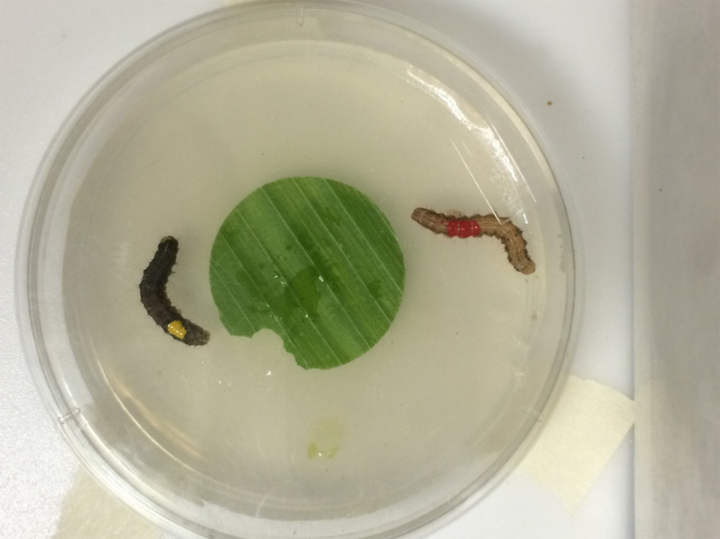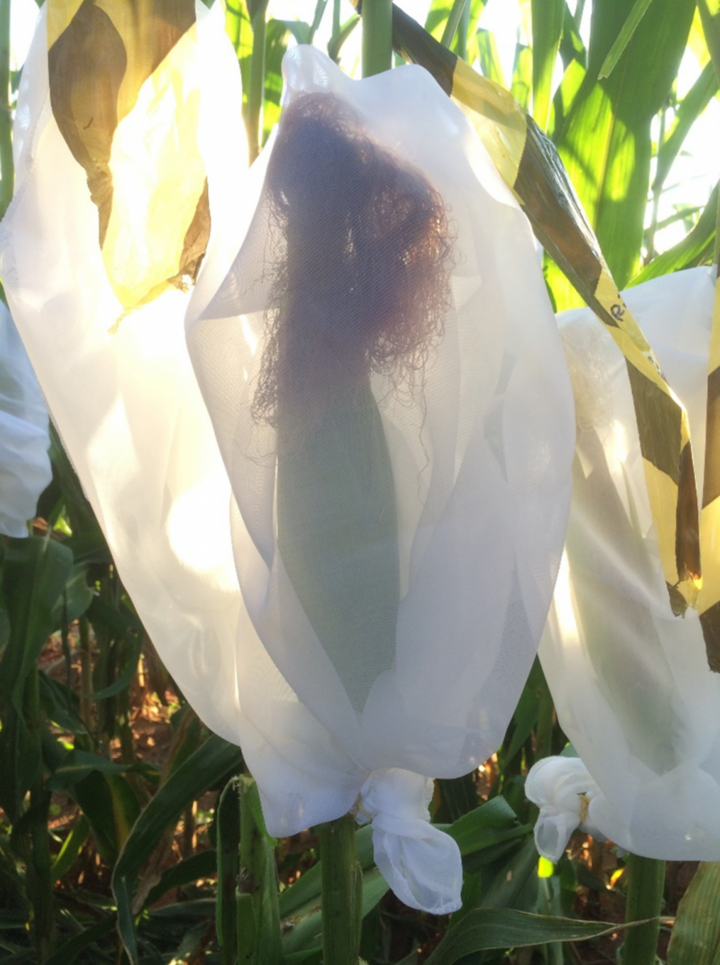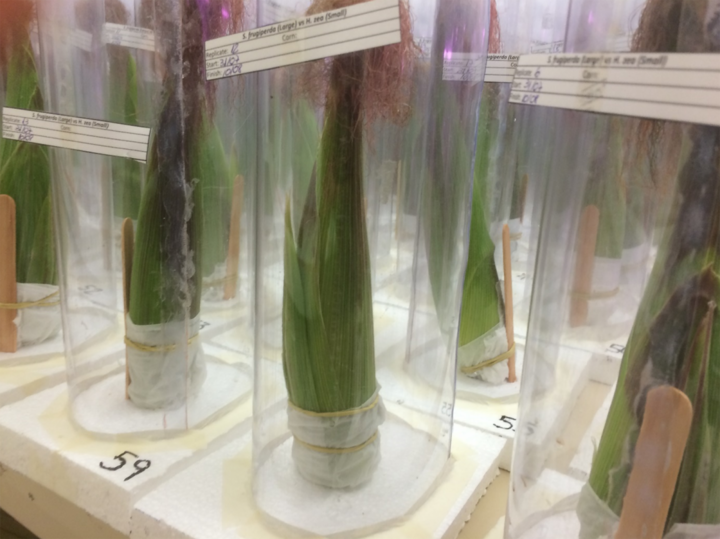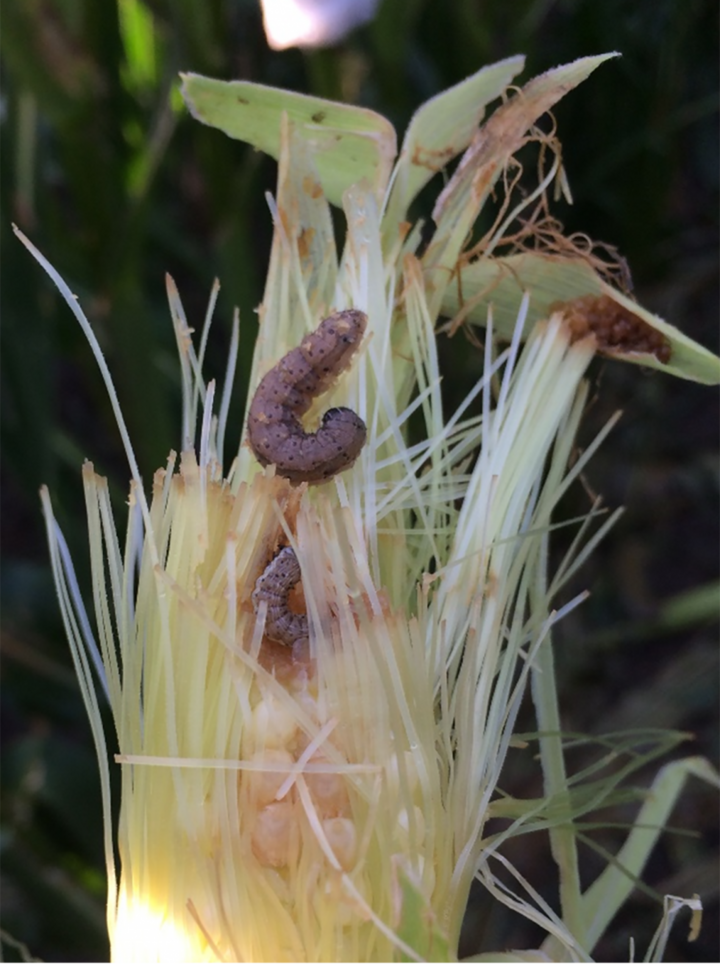Nebraska-Brazil Collaboration Studies New and Old Corn Insect Pests
US farmers may not be very familiar with the Old World bollworm, Helicoverpa armigera (Lepidoptera: Noctuidae). This species is native to Asia, Europe, Africa, and Australasia where it is a significant agricultural pest, causing billions of US dollars in damages annually due to yield losses and insecticide application. The Old World bollworm, which feeds on corn ears, is now causing damage to crops in the Western Hemisphere.
For the last five years the species has been a problem for Brazilian crops, adding to the economic damage already caused by other noctuids such as the fall armyworm (Spodoptera frugiperda) and corn earworm (Helicoverpa zea). Unfortunately, this pest has impressive migratory abilities and has been increasing its range since its first detection in Brazil. While Old World bollworm moths have now been found on the western coast of Florida, the pest has not become established yet in North America.
With the introduction of this pest looming for North America, it is important to understand how it might affect US crop production. One factor affecting its status will be how it interacts with pests already established in the United States. Pest species that rely on the same food source (corn ears) will be in competition with each other and may engage in predation or cannibalism. From a bioecological standpoint Old World bollworm is similar to several pests already active in US corn, including the corn earworm and fall armyworm, both of which present cannibalistic and predatory behavior. In Brazil, these species are already cohabiting in diverse agricultural crops, as well as sharing the same feeding site.
Therefore researchers from the University of Nebraska-Lincoln in partnership with two Brazilian researchers, Edson Luis Baldin from the São Paulo State University and Silvana V. de Paula Moraes (EMBRAPA), today at the University of Florida, are investigating interactions of the main corn ear-feeding pests in South and North America (Figures 1-4).




The introduction of the Old World bollworm in Brazil (probably in 2008, with identification in 2012-13) led to a drastic change in pest management in crops such as corn, soybean, and cotton. As the Old World bollworm becomes prevalent in Western hemisphere crops, it can be assumed that existing pest populations may change their population dynamics. When this occurs, the tools used to manage agricultural pests (integrated pest management and insect resistance management) will need to be improved. It is our responsibility to better understand these interactions to properly manage these economically disruptive species in crops.
So far, the collaborations between Nebraska and Brazil have resulted in nine research publications. Four of the most recent are summarized below.
1. Battle in the New World: Helicoverpa armigera versus Helicoverpa zea (Lepidoptera: Noctuidae). J.P.F. Bentivenha, J.P., S.V. Paula-Moraes, E.L.L. Baldin, A. Specht, I.F. da Silva and T.E. Hunt. 2016. PloS one, 11(12), e0167182.
Interaction studies between the species were evaluated in interspecific and intraspecific scenarios under laboratory and field conditions. Both species exhibit high cannibalism/predation rates, and larval size was the primary factor for larval survival in the interaction studies. Corn earworm has an advantage in intraguild interactions with Old World bollworm in corn. Overall, the results from this study indicate that corn might play a role as a source of infestation.
2. Intraguild interactions and behavior of Spodoptera frugiperda and Helicoverpa spp. on maize. J.P.F. Bentivenha, D.G., Montezano, T.E., Hunt, E.L.L. Baldin, J.A. Peterson, V.S. Victor and S.V. Paula-Moraes. 2017. Pest Management Science.
The intraguild interactions of these species were assessed by determining the survival of larvae in interaction scenarios with non-Bt corn silks and ears. This study provides significant information regarding noctuid behavior and larval survival during intraguild interactions, which may impact pest prevalence and population dynamics, thereby affecting integrated pest management and insect resistance management of these species in corn.
3. Attack and defense movements involved in the interaction of Spodoptera frugiperda and Helicoverpa zea (Lepidoptera: Noctuidae). J.P.F. Bentivenha, E.L.L. Baldin, D.G. Montezano, T.E. Hunt and S.V. Paula-Moraes. 2017. Journal of Pest Science 90(2), 433-445.
Interaction scenarios were assessed in arenas in the presence and absence of food. Corn earworm shows higher aggressive movements. However, fall armyworm takes more advantage during the interactions. This study provides relevant information regarding the interaction during intraguild interaction, which might influence the population dynamics and the competitive displacement of pest species sharing the same food source.
4. Intraguild competition of three noctuid maize pests. J.P.F. Bentivenha, E.L.L. Baldin, T.E. Hunt, S.V. Paula-Moraes and E.E. Blankenship. 2016. Environmental Entomology 45(4), 999-1008.
Western bean cutworm (WBC), fall armyworm and corn earworm were exposed to competition scenarios with corn silk or ears. Survival of WBC was significantly lower. For fall armyworm, survival remained high in the different competition scenarios and corn earworm had a high rate of cannibalism and higher survival when competing against WBC. The absence of a competitor for the feeding source may confer an advantage to the larval development of fall armyworm and corn earworm.
Related publications include:
- Plant-to-plant movement of Striacosta albicosta (Lepidoptera: Noctuidae) and Spodoptera frugiperda (Lepidoptera: Noctuidae) in Maize. L.E.R. Pannuti, S.V. Paula-Moraes, T.E. Hunt, E.L.L. Baldin, L. Dana and J.V. Malaquias. 2016. Journal of Economic Entomology. 2016, 1-7.
- On-Plant Larval Movement and Feeding Behavior of Fall Armyworm (Lepidoptera: Noctuidae) on Reproductive Corn Stages. L.E.R. Pannuti, E.L.L. Baldin, T. E. Hunt and S. V. Paula-Moraes. 2015. Environmental Entomology. 2015, 1–9.
- Western bean cutworm survival and the development of economic injury levels and economic thresholds in field corn. S.V. Paula-Moraes, T.E. Hunt, R.J. Wright, G.L. Hein and E.E. Blankenship. 2013. Journal of Economic Entomology. 106(3): 1274-1285.
- On-Plant Movement and Feeding of Western Bean Cutworm (Lepidoptera: Noctuidae) Early Instars on Corn. Environmental Entomology. S.V. Paula-Moraes, T.E. Hunt, R.J. Wright, G.L. Hein, and E.E. Blankenship. 2012. 41(6): 1494-1500.
- Cost-effective binomial sequential sampling of western bean cutworm, Striacosta albicosta (Lepidoptera: Noctuidae), egg masses in corn. S.V. Paula-Moraes, E.C. Burkness, T.E. Hunt, R.J. Wright, G.L. Hein, W.D. Hutchison. 2011. Journal of Economic Entomology. 104(6):1900-1908.

